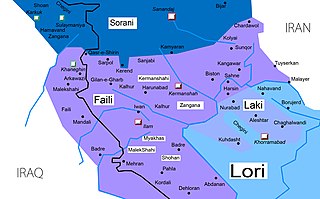Southern Kurdish: Difference between revisions
No edit summary |
mNo edit summary |
||
| Line 17: | Line 17: | ||
|lingua=58-AAA-c |
|lingua=58-AAA-c |
||
|script =[[Perso-Arabic script|Perso-Arabic]] ([[Kurdish alphabets#Sorani alphabet|Sorani alphabet]]) |
|script =[[Perso-Arabic script|Perso-Arabic]] ([[Kurdish alphabets#Sorani alphabet|Sorani alphabet]]) |
||
|map= |
|map= SOUTHERN_KURDISH.JPG |
||
|mapcaption= Southern Kurdish Area |
|mapcaption= Southern Kurdish Area |
||
}} |
}} |
||
Revision as of 09:36, 19 January 2014
| Southern Kurdish | |
|---|---|
| فیلی | |
| Native to | Eastern Iraq, Western Iran |
| Region | Western Iran and neighboring eastern Iraq |
Native speakers | 4 million in Iran (2000)[1] |
| Perso-Arabic (Sorani alphabet) | |
| Language codes | |
| ISO 639-3 | Either:sdh – Kermānšānilki – Laki |
| Linguasphere | 58-AAA-c |
 Southern Kurdish Area | |
Southern Kurdish (Southern Kurdish: کوردیی خوارگ), also called Kermānšāni, is one of the Northwestern Iranian languages and is predominantly spoken in western Iran and eastern Iraq. In Iran, it is spoken in the provinces of Kermanshah (Kermānšān) and Ilam. In Iraq it is spoken in the region of Khanaqin (Xaneqîn), all the way to Mandali, Pehle. It has more than one million speakers in the city of Baghdad. It is also the language of the populous Kurdish Kakayî tribe near Kerkuk and the Zengenes near Kifrî. There are also populous diasporas of Southern Kurdish Dialects group found in the Alburz mountains.
Southern Kurdish which is spoken in Iran in Ilam and Kermanshah provinces, is very similar to Laki which is spoken in Lorestan, Hamedan, and Kermanshah. Southern dialects standard written form is like standard Persian and have not been adequately studied.[2]
Dialects
The dialects of Southern Kurdish are:
- Kalhori کلهری
- Feyli, referring to the Feyli tribe; also known an Ilami, after Ilam Province. It is spoken in eastern Iraq in the Khanaqin region of Diyala province near the Iranian border, and in western Iran in Ilam province and parts of Kermanshah province, by the Feyli Kurds. Mahaki is a sub-dialect. It is spoken by the tribe of Ali Sherwan (Beyrey) in Ilam, and by almost all Feyli Kurds in Baghdad, Mandali, Badrah, and Zorbatiah in Iraq. It shares many features with Sorani.[3]
- Kolyaî or Kermanshahi (Kermānšānî) is spoken mostly in western Iran, in and around the city of Kermanshah (Kirmaşan).[4] It also shares many features with Sorani.
- Garrusi (Gerrûsî) (Bijari)
- Malekshahi (Melikşay)
- Sanjâbi (Sencabî) referring to the Sanjâbi people. It's a branch of Kalhor language family
- Laki (see)
See also
External links
References
- ^ Kermānšāni at Ethnologue (17th ed., 2013)

Laki at Ethnologue (17th ed., 2013)
- ^ Medieval Islamic Civilization: A-K, index By Josef W. Meri, Jere L. Bacharach
- ^ Ranjbar, Vahid. Dastur-e Zaban-e Kurdi-ye Kermanshahi. Kermanshah: Taq-Bostan. 1388
- ^ Ranjbar, Vahid. Dastur-e Zaban-e Kurdi-ye Kermanshahi. Kermanshah: Taq-Bostan. 1388
↑ 5. Kamandar Fattah, Les Dialectes kurdes méridionaux: étude linguistique et dialectologique. Louvain, Peeters, 2000, p. 55-62 ↑ 6. Kamandar Fattah, Les Dialectes kurdes méridionaux: étude linguistique et dialectologique. Louvain, Peeters, 2000, p. ۵۵-۶۲
